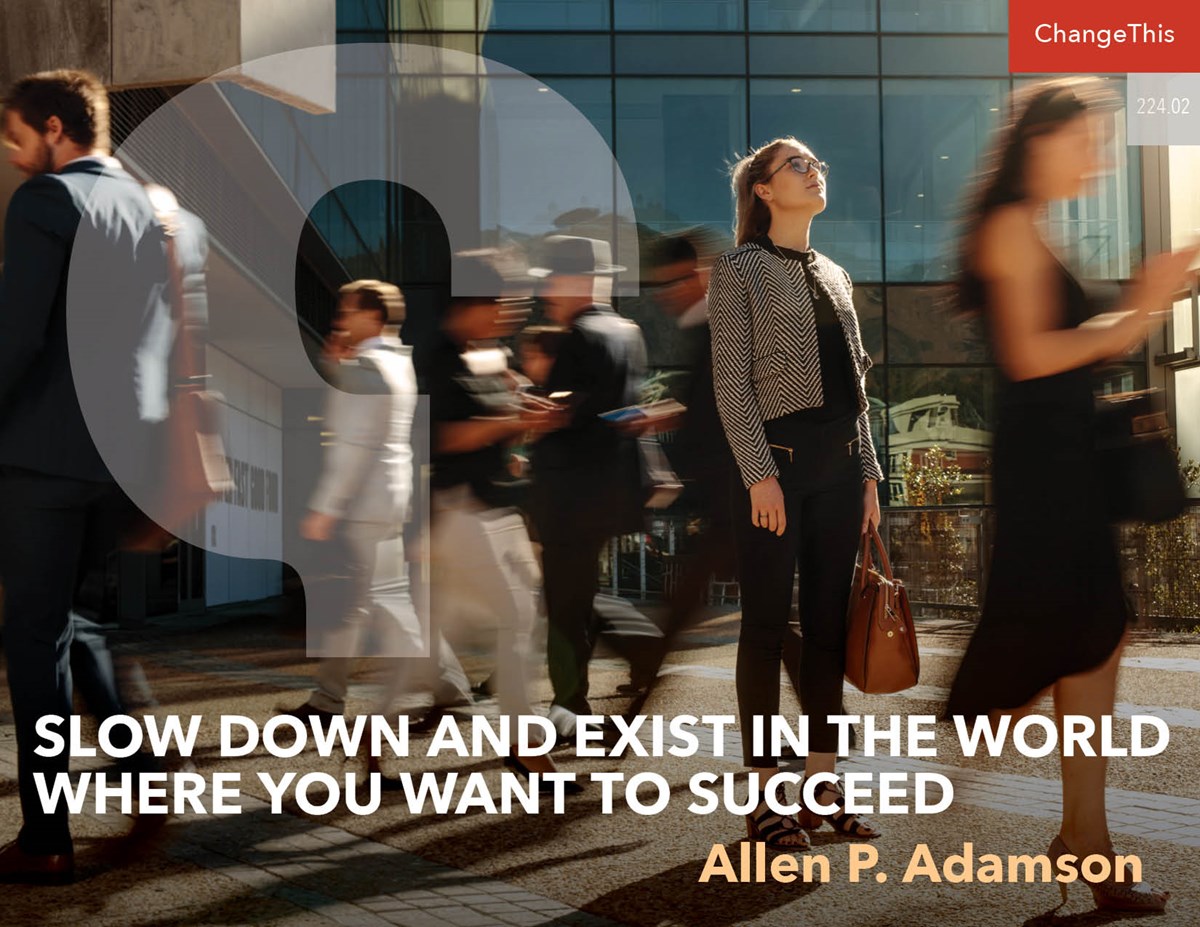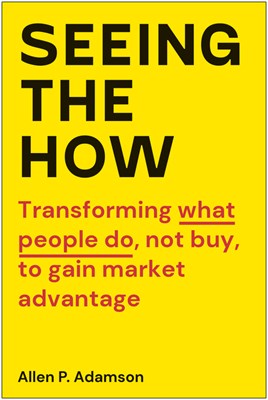Slow Down and Exist in the World Where You Want to Succeed
May 10, 2023
Finding your brand's focus often starts with standing up and moving from behind your desk, putting down your phone, and looking away from your screens.
When you teach someone how to throw a baseball, you tell them to look where they want the ball to go, step toward where they want the ball to go, and then throw the ball where they want it to go. To the novice thrower, this can sound frustratingly uninstructive. So, too, is the simple complexity that is viewing your business in a way that narrows your perspective to one that can provide an experience that is specific, unique, and superior to all the others.
The strongest brands have a clear focus on what they do, what they want to stand for, and to whom they can provide it, and they offer what they do in the same way and with the same quality every time they do it. The clearer the focus, the stronger the brand. Companies that try to veer off the path—getting into what they consider collateral offerings—often get into trouble. Consumers are smart enough to question the connection. A key factor in brand success is to concentrate on what you do and do it well.
As New York Times columnist Tom Friedman once said to me in a conversation a few years back, “Average is over.” In this hyper-connected world, “good enough” is no longer enough. Taking this one step further, relative to seeing new opportunities, consider how to “unbundle” one particular dimension of an experience, and then become the expert in that area. This is a lens that has provided success to a number of market innovators.
And it often starts with standing up and moving from behind your desk, putting down your phone, and looking away from your screens. You have to exist in the world where you want to succeed. If you don’t know what it’s like to shop at a supermarket, you are unlikely to understand how to create an experience that will make your supermarket do something that no one else does. All of this is easier said than done, of course. When Friedman and I talked about how the idea for his book Thank You for Being Late originated, he told me that he never minded if one of his appointments ran late and he was left waiting in reception for longer than expected. He always saw this as a gift of unstructured time in a space that he hadn’t chosen, and it’s where he’s had some of his best ideas or come to an idea for a solution to a previously intractable problem.
TOO BUSY TO SEE WHAT WE NEED TO SEE
We all have our version of missing things because we’re too busy to see them. In my younger days, I went out for a run on most mornings. Let me be clear: I had no great ambitions or quests for a personal best. I ran not too far, two or three miles, and I ran them not that quickly (though I will keep my dignity intact and not share my pace).
While I would make my way around Central Park’s reservoir, I’d enjoy the view, the air, the music playing through my headphones—and it was in those moments that I had some of my best ideas. Challenges that felt impossible would unravel at a slow, incremental pace the way a tangled knot can be addressed one bit of tangle at a time. This was the kind of thinking I could never do sitting at my desk, no matter how clear my mind was and no matter how on top of my inbox I managed to be.
It isn’t a secret that we all, to some degree, suffer now from some version of too-busy syndrome. We all find ourselves believing that if we are doing two things, even three, at a time, we are more productive. Those of us in the corporate world overschedule ourselves, and we do so deliberately.
In my previous book, Shift Ahead, I mention a meeting I had with then-CMO of Facebook, Gary Briggs. He talked about how, if you were working on a priority project, you got what was called the “Hall Pass,” which would allow you to clear your calendar of most meetings in order to fully dive into and focus on a project that took you outside of your everyday tasks.
For my generation, it used to be that if you wanted to see what was going on outside of your immediate, corporate existence, you could just turn on the television. There before you would be ads for all sorts of products and services, certainly any about which you would want to be aware. And that viewing did offer some sense of what was going on in the world, which is how senior management would look at things. When I was at Unilever it was “Did you see that ad that Colgate just ran for a new product? We’ve got to get going on something here.” At a different gig, it was “Did you see what I just saw on television last night? Look what they’re doing in the insurance category.”
STEP OUTSIDE OF YOUR BUBBLE
The world of media no longer allows you to simply watch television to get a full sense of things, as anyone over the age of fifty knows. The list of offerings is dictated by an algorithm driven by what I click on and watch.
My demographics, in every sense of the word, narrow the world to what someone out there thinks a man of my age, of my socioeconomic bracket, of my region, of my profession, of my predilections wants to see. And I’m not casting aspersions on their accuracy. This is about how my, your, everyone’s experience is a curated view crafted on our behalf, unbeknownst to us. The effect is that I am unable, without real effort, to identify what I or companies for whom I consult might want to do, offer, or bring to the world—because my own perspective is so siloed.
This was made as clear as the sky is blue when I was in Ann Arbor, Michigan, speaking to a marketing class at the Ross School of Business. As is my usual, I found my way to the Graduate Hotel gym’s treadmill. Watching the morning news on my phone, I was presented with ads for companies and products I had never heard of.
It wasn’t that I lived an ad-free life. Even in the age of streaming, I still use the ad-supported version of Hulu, I watch plenty of sports, and I get at least 50 percent of my news from live (not written) sources. I see advertising—or so I thought.
What I was in the process of learning firsthand was the extent to which my existence, my exposure to the world and all that happens in it, has been slowly but surely (or, not so slowly) whittled away such that what I know of the world is a highly curated, narrow range, dictated not by me but by what my viewing and scrolling habits suggest about me. As someone who fancies myself aware of what is going on, this was startling.
So there it was. I was about to speak to a class at the University of Michigan and was staying at a hotel on campus—and as a result, the advertising directed at me was incredibly different from what I saw when the screen thought I was a sixty-something white guy on the Upper East Side of Manhattan. I began to wonder: How could I step out of my bubble?
I turned to my media partner at Metaforce, Bill Heilman. I asked him if he could configure my phone and home TV so it would think I was different people, in different places, with different interests, vulnerable to different clickbait, and every other metric I could think of.
What Bill explained to me was fascinating. This less-curated view is only the tip of what is out there, unseen by me unless I make a concerted effort.
“As marketers, we always talk about trying to walk in the shoes of the consumer, and we’ve traditionally done this with ethnographic research, going into people’s homes and seeing what they use and how they use it. But what I think is more interesting is what you might learn by creating different personas and starting to look at things through the world of these different consumers firsthand,” Bill said. Browsing behavior dictated by an entirely different personal profile would result in a plethora of views into worlds you can’t otherwise see.
“If I, Bill, like to buy fragrances, which I do, I will spend time on a site like Kilian,” Bill continued. “Soon, when I go through Google, I will start seeing fragrance-related advertising. I might even see an ad for a laundry detergent that is fragrance oriented. The next step, then, is to go to different platforms, disguise as various members of your potential audience, with different anchors (my anchor being fragrances), and see where this leads Google and other targeted advertising to go.” This allows you to step outside of these highly curated silos in which we all live (with varying degrees of awareness) and see the world from as many angles as possible.
I would argue that you need Facebook’s “Hall Pass,” and you need to stop using curated advertising to be able to spot the obvious. You need to get out of the office, shake up your routine, and step away from your weekly, daily, and multiple-times-a-day meetings. If you are always in back-to-back meetings and back-to-back calls, scanning lots of data, and absorbing one-pagers, you’ll be unable to see the forest for the trees.
WHEN THE WALKMAN WAS THE IT THING
Taken to the next level, we can see companies that have successfully drilled down to the heart of an issue or service and made it not just their core but their entire business. Many of them seem obvious and unworthy of note, so ingrained are their ideas, but there was a time before they existed. And that “before time” exists for other services, products, and problems unsolved; this is where you come in.
You could be the person who does their own version of what Sony did in 1979 with the Walkman those many, many years ago, which was a perfect example of focusing in.
As Steven Fuld, senior vice president of marketing at Sony, told me, “The Walkman was positioned to give the listener control in their life.” Sony produced a product that reduced to its essence what someone would need to have music playing no matter where they were.
The original Walkman had no radio, no bells and whistles; it was a cassette player with the attendant buttons (play, fast-forward, reverse) and a single port into which a single pair of headphones plugged. The sound quality was previously only available in your den sitting in front of large speakers connected to a collection of large electronic components.
Sony understood that this was more than a new product launch. It was selling a new experience to anyone who wanted to know what it was like to walk out on the street, on the treadmill, or into a subway car and have their favorite song playing in their head. It may be hard to recall, but there was a time before 1979 when such a thing simply did not exist. At that time, music played into an entire room, had to be for the ears of everyone within listening distance, and was confined to those spaces where a music source, wires, an outlet, and speakers could be found.
In order to paint the picture as vividly as possible, Sony sent a woman by the name of Maki Kumagai out into NYC during the summer of 1978 to just walk around wearing a Walkman. Kumagai was the original influencer/guerilla marketer.
The original intent of the product was to show that music could be mobile and controlled by the individual listener. Commuting to and from work or school, taking a walk, or running errands, the sounds that previously only existed at home—where you could play your cassette tapes or albums and hear them through speakers that were built to stay put—could now live in your pocket. As Fuld describes it,
Sony took what they did, [creating] devices for home entertainment, and drilled down to its essence to identify an aspect of that experience they could offer their customers in a form that was portable and pocket-sized. They made it as small as they could, surrounding the space into which the cassette went with just enough mechanics and space for batteries to allow it to run. In this way, they showed the extent to which this control was available to anyone willing to purchase a Walkman.
Talk about changing the consumer experience!
One of my favorite ads of all time is one Sony ran in 1988 (which you can find by searching “Sony 1988 Walkman ad” on YouTube), for which the company won art direction awards, that shows a monkey standing at a beautiful vista by the ocean, holding a Walkman, with the headphones in its ears, as a well-known opera aria plays. The voiceover tells us that the Walkman has forever changed the way we listen to music—and it was not speaking hyperbolically.
By drilling down into the essence of its product—putting sound in the ears of people on the move—Sony helped create a society where words, music, news, and entertainment of all mediums travel with us.
FOCUS IN AND DRILL DOWN
Even some of the most innovative, creative, and driven entrepreneurs understand that it’s impossible to pursue every opportunity. As Apple cofounder Steve Jobs said at a Worldwide Developers Conference in 1997, “People think focus means saying yes to the thing you’ve got to focus on. But that’s not what it means at all. It means saying no to the hundred other good ideas that there are. You have to pick carefully. I’m actually as proud of the things we haven’t done as the things I have done. Innovation is saying no to one thousand things.”
As your company grows, you’ll be faced with all kinds of opportunities. The bigger you get, the more choices you’ll face. It’s exciting. It’s challenging. It holds incredible promise. But it can be deadly. If you pursue too many different courses, you’ll lose your focus, you’ll find it difficult to execute your business strategy, you’ll burn out your people, and you’ll burn through your cash. When you focus in and execute better than anyone else can, you can offer an experience that improves someone’s ability to do, play, and participate in ways they couldn’t before.




